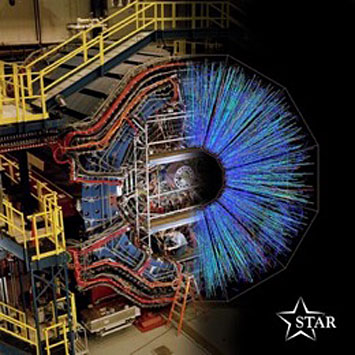Integrating Scientific Computing into Science Curricula
An introductory scientific computing course that started out in 2015 as a weekly high-school after-school program developed by Brookhaven Lab is now part of the curriculum for a new scientific computing minor offered at nearby Adelphi University
May 13, 2019
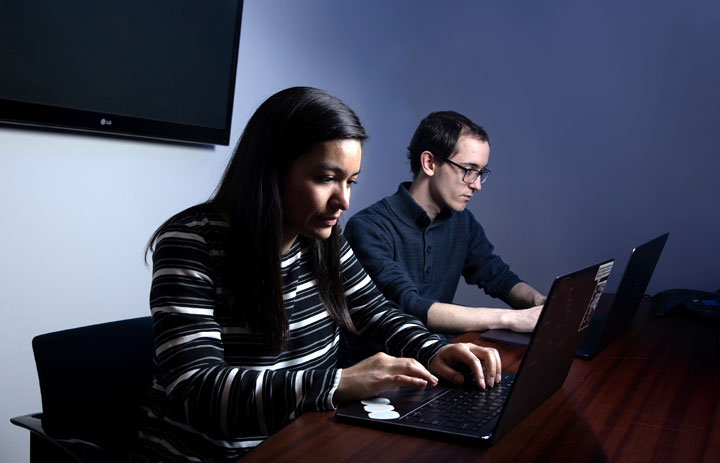 enlarge
enlarge
Adelphi University junior Jennefer Maldonado and senior Gerard Boniello were among the 15 students enrolled in an introductory scientific computing elective that was first offered last spring. The elective—which was based on content that Brookhaven Lab technology architect David Biersach developed for a weekly high-school extracurricular program he started in 2015—is now part of a new scientific computing minor at Adelphi. Maldonado is one of the students pursuing the minor, the classes for which will begin in the fall semester. Adelphi is the first and currently the only university in New York State to offer such a minor. Credit: Adelphi University.
This story is being jointly issued by the U.S. Department of Energy’s Brookhaven National Laboratory and Adelphi University. Brookhaven Lab media contacts: Ariana Tantillo, 631-344-2347, atantillo@bnl.gov or Peter Genzer, 631-344-3174, genzer@bnl.gov; Adelphi University media contact: Todd Wilson, 516-237-8634, twilson@adelphi.edu.
With guidance from the U.S. Department of Energy’s (DOE) Brookhaven National Laboratory, nearby Adelphi University just added a new minor in scientific computing—the use of computers to solve real-world science problems. Students enrolled in the minor will begin taking classes this fall, and the hope is that they will join the computing workforce of the future on Long Island, New York.
“This collaboration between Brookhaven and Adelphi is an example of a national lab teaming with academia to elevate the quality of STEM [science, technology, engineering, and mathematics] training in the United States,” said Noel Blackburn, manager of university relations and DOE programs within Brookhaven Lab’s Office of Educational Programs (OEP). “It will help close the knowledge gap between scientists and science students, increasing the competitiveness of our next generation of professionals for the national workforce.”
“Scientific computing is an urgent need in the scientific community,” said Christopher Storm, associate provost for faculty advancement and research at Adelphi. “As a university, we have an important role and opportunity to address this need by bringing together faculty across the science and computing disciplines to better integrate our curriculum. By partnering with Brookhaven in faculty and curriculum development, we have developed a scientific computing minor that will prepare our undergraduates who are majoring in science to succeed in the scientific community.”
Urgent need in modern-day science
Today, computational techniques have become indispensable to solving real-world science problems.
For example, consider physicists at the Relativistic Heavy Ion Collider (RHIC)—a DOE Office of Science User Facility at Brookhaven—who are conducting experiments to understand what the early universe was like and the matter we observe today. Following experiments in which they collide gold ions (and other elemental nuclei) at nearly the speed of light to recreate the conditions that existed millionths of a second after the Big Bang, they rely on pattern-recognition algorithms to reconstruct the trajectories of the tens of thousands of particles produced. They need statistical methods for analyzing the data from the billions of collision events that take place to reduce uncertainty in their measurements and make reliable conclusions. And they depend on simulation and modeling tools to generate theory-based predictions they can compare with experimental results.
“Most educators and students think that scientists spend the majority of their time conducting experiments in the lab or field,” said David Biersach, a technology architect in Brookhaven Lab’s Information Technology Department (ITD). “But the reality is that modern-day scientists are often sitting in front of a computer collaborating with peers and processing, analyzing, and extracting insights from the data they’ve collected. The terrible irony is that scientific computing constitutes much of their activities, yet there are so few resources that prepare them to write custom code.”
A national problem in scientific computing literacy
Part of this lack of preparedness stems from the paucity of computer programming courses available to young students. Statistics released by the National Center for Education Statistics reveal that the percentage of U.S. high schools offering such courses has been in sharp decline over the past two decades, with the national average now less than 10 percent. And on Long Island it is only about seven percent.
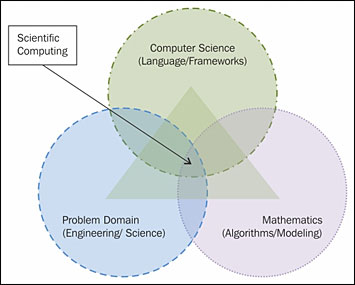 enlarge
enlarge
Scientific computing lies at the intersection of computer science, mathematics, and domain science. Credit: Mastering Python Scientific Computing.
In college, students majoring in science take several mathematics courses and possibly computer science courses, but scientific computing has a different focus and requires skills that are not necessarily developed through a traditional curriculum. For example, code speed and accuracy are very important in scientific computing, but these programming aspects are not prioritized in computer science. Similarly, computer science coursework and exams are based on closed-form problems with known optimal solutions, whereas scientific computing presents students with open-ended problems for which optimal solutions do not yet exist.
“Scientific computing is a triple helix of science, math, and computing,” explained Biersach. “It is applied computer science. Unfortunately, for many science students in the United States, nobody ever told them that to advance their science they will someday have to write code.”
Without foundational programming skills, science students are often ill-prepared for research internships, which are key to STEM retention. According to Biersach, scientists across the DOE have witnessed this latency firsthand. Students with no prior coding experience often spend the beginning of their internships figuring out how to instruct computers to perform basic data-processing tasks instead of learning domain knowledge from their mentors and conducting experiments in the lab.
The need for individuals qualified in scientific computing can also be seen by the large number of open positions at national labs and other research institutions across the country. The U.S. Bureau of Labor Statistics projects that among the STEM fields, computing and mathematics job openings will grow the fastest into the early 2020s.
Local efforts to prepare next-generation scientists
Biersach set out to locally help address this national problem in 2015, when he started running a series of after-school “clubs” in scientific computing at high schools across Long Island. During these once-a-week hour-long workshops, high schoolers passionate about STEM learn how to use the C++ language to program computers hosted in the Amazon cloud.
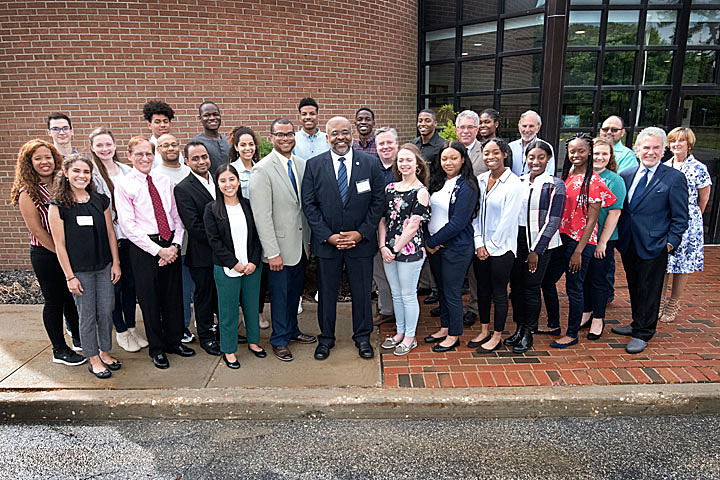
Last summer, 20 STEM undergraduates came to Brookhaven Lab for a new scientific computing skills-building program funded by the National Science Foundation.
“On Long Island, incredible economic disparity can exist between two school districts, to the extent that one district could have the latest-generation iPads while another is still running Windows 95,” said Biersach. “The cloud is a great enabler and equalizer in this sense. By provisioning the machines in the cloud, every student can access the same virtual machines at school or even at home, regardless of their local computer resources.”
Working through exercises based on active research projects at Brookhaven Lab, participants learn how scientific computing impacts all scientific disciplines. They build the skills needed to translate scientific formulas into accurate and efficient code, store and analyze very large datasets, and effectively visualize complex data. The idea is that students with these skillsets will be better prepared to conduct research at national labs and other institutions, initially as interns and later as scientists. Students taking science research courses offered by their high schools also have the opportunity to apply the acquired skills to their research projects, enhancing their chances of success at science competitions.
Several high schools—as far west as Freeport and as far east as Westhampton and Riverhead—have partnered with Brookhaven over the past four years to introduce their students to scientific computing. In Riverhead, the after-school club has been extended to the middle-school level.
The program has since led to similar opportunities at Brookhaven. Every year, students from the Women in Science and Engineering (WISE) program at Stony Brook University come to Brookhaven Lab for scientific computing workshops. Over the summer, Brookhaven offers introductory (SciComp 101), advanced (SciComp 201), and applied scientific computing (SciComp 301) workshops for junior high, high school, and undergraduate students, respectively. In summer 2016, with the support of the New York State Department of Education Collegiate Science and Technology Entry Program (CSTEP) for underrepresented minorities, 18 undergraduates came to Brookhaven Lab for a SciComp 102 course. Last summer, Brookhaven Lab hosted 20 scholars from the National Science Foundation’s Louis Stokes Alliances for Minority Participation program for a three-week introductory scientific computing workshop. The same workshop will be offered again this summer, but for eight weeks and to twice as many students.
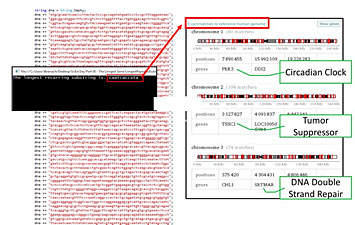 enlarge
enlarge
Scientific computing can be integrated with a biology lesson focusing on DNA sequencing. In this example, students write code to look for DNA sequence homology within the human genome.
“We’re trying to establish Brookhaven as a leader in the space of scientific computing education,” said Biersach.
While all of these educational initiatives have expanded opportunities for students to learn how to code, scalability is always the limiting factor.
“We can only bring the extracurricular clubs to so many high schools or fit so many students in our classrooms over the summer,” said Biersach. “I think a better approach is to get the curriculum into schools, at least as an elective to start and ideally as a degree program. Interestingly, even the curriculum for Advanced Placement (AP) Physics does not include computation despite the fact that physics is one of the most computationally intensive STEM fields. Another challenge is that many science educators have not coded in decades, and thus they may not be comfortable teaching the material.”
“A number of states are incorporating computer science standards into their K–12 system,” said OEP Manager Kenneth White. “Embracing these standards and incorporating scientific problem-solving using computing will ensure better preparation of students to tackle the challenges of modern-day science. We hear how important scientific computing skills are from our mentors. Accordingly, we are tackling this challenge in many ways to encourage students and educators alike to incorporate scientific computing into their portfolio of science research tools. The work by Adelphi is very rewarding for our team.”
From high-school extracurricular to university minor
To this end, for a week last summer, Biersach trained science educators on how to deliver scientific computing lessons (based on SciComp 301) aligned to biology, chemistry, physics, and environmental science.
“We tend to put coding in its own box, but coding can be introduced right in line with the existing curriculum,” said Biersach.
Professors from Adelphi University and Medgar Evers College of the City College of New York (CUNY), and an instructor from St. Anthony’s High School participated in the training. As a result of this workshop, St. Anthony’s added a scientific computing elective to its course selections last year, becoming the first private high school in New York State to do so. This year, 40 students are enrolled in the elective.
The impact also extended to the university level. In the spring 2018 semester, Adelphi offered an introductory course based on the content that Biersach developed—“Survey of Scientific Computing”—with 15 students enrolled.
Senior Gerard Boniello, who is pursuing a double major in mathematics and computer science, was one of these students.
“I had taken a lot of programming classes prior to the class, but some of the logic behind the programs was different than what I’m used to,” said Boniello. “There was a specific way to go about different problems, with no solutions ever really sharing code snippets. The diagrams that we were working with were hard to visualize when we first started coding, but it was very interesting to see how much you can model and simulate with the right tools. We inputted real-world data into the models and saw how variables would manipulate them.”
“I took the elective to learn about the scientific use of computing and the general applications of computing in bioinformatics,” said Andrew Li, a biology major in his senior year. “I had absolutely no experience prior to this class.”
This introductory course is now part of a scientific computing minor that has been formalized within Adelphi’s Department of Mathematics and Computer Science. The first group of students to pursue the minor—the first of its kind in the state—will begin taking classes in the fall 2019 semester.
“We are very excited to offer this new minor in Adelphi’s College of Arts and Sciences, which embodies the liberal arts spirit of the university,” said Kees Leune, an assistant professor in the department and the lead faculty member on the development of the minor. “The ability to take an interdisciplinary approach to problem solving across science disciplines sets our students up for success early on in their academic careers.”
Department chair Salvatore Petrilli supported the implementation of the curriculum for the minor. In developing the curriculum, Adelphi received guidance from Brookhaven on the skillsets that are in high demand by modern science. To complete the minor, students are required to take Survey of Scientific Computing along with courses in calculus, computer programming, applied problem solving, statistics and data analysis, and operating systems, as well as advanced courses in computation relevant to their majors.
“The minor allows me to cater my courses to my interests, and the curriculum complements what I’m learning in many of my math and computer science courses,” said junior Jennefer Maldonado, who took the scientific computing elective last year and has decided to pursue the minor along with her dual major in mathematics and computer science. “It is a great way to combine my two majors in a creative way while applying my skills in scientific computing in the STEM fields that I do not encounter on a daily basis.”
This summer, through DOE’s Science Undergraduate Laboratory Internship program, Maldonado will be programming for Brookhaven’s National Synchrotron Light Source II, a DOE Office of Science User Facility. After completing her undergraduate studies, she plans to obtain her PhD in applied mathematics.
“From what I’ve learned, there is a huge demand for students with skills in scientific computing,” continued Maldonado. “Graduating with a minor in scientific computing will allow me to have an edge up over other students who may be applying to similar internships, graduate programs, or jobs in the future. I think more schools should really consider following in Adelphi’s footsteps.”
Brookhaven hopes that Adelphi will set an example for other private and public universities to adopt scientific computing in their course and degree program offerings, making students more competitive applicants for educational and career opportunities. Discussions between Brookhaven and other universities about adopting scientific computing in course and degree program offerings are already underway.
“Currently, no university in New York offers a scientific computing major,” said Biersach. “Maybe that will soon change.”
About Brookhaven National Laboratory
Brookhaven National Laboratory is supported by the Office of Science of the U.S. Department of Energy. The Office of Science is the single largest supporter of basic research in the physical sciences in the United States, and is working to address some of the most pressing challenges of our time. For more information, please visit science.energy.gov.
Follow @BrookhavenLab on Twitter or find us on Facebook.
About Adelphi University
Adelphi University, New York, is a highly awarded, nationally ranked, powerfully connected doctoral research university dedicated to transforming students’ lives through small classes with world-class faculty, hands-on learning, and innovative ways to support academic and career success. Adelphi offers exceptional liberal arts and sciences programs and professional training, with particular strength in our Core Four—Arts and Humanities, STEM and Social Sciences, the Business and Education Professions, and Health and Wellness.
Recognized as a Best College by U.S. News & World Report, Adelphi is Long Island’s oldest private coeducational university. It serves more than 8,100 students at its beautiful main campus in Garden City, New York—just 23 miles from New York City’s cultural and internship opportunities—and at dynamic learning hubs in Manhattan, the Hudson Valley and Suffolk County, as well as online.
More than 115,000 Adelphi graduates have gained the skills to thrive professionally as active, engaged citizens, making their mark on the University, their communities and the world.
2019-14374 | INT/EXT | Newsroom




